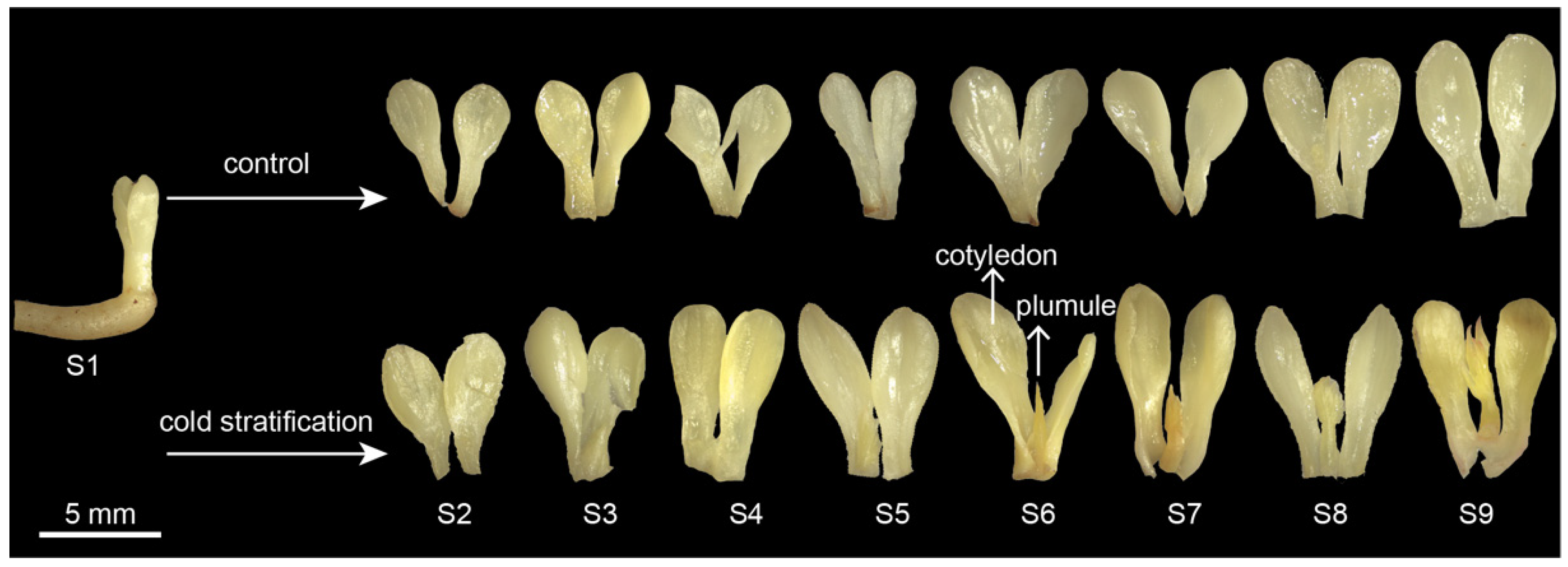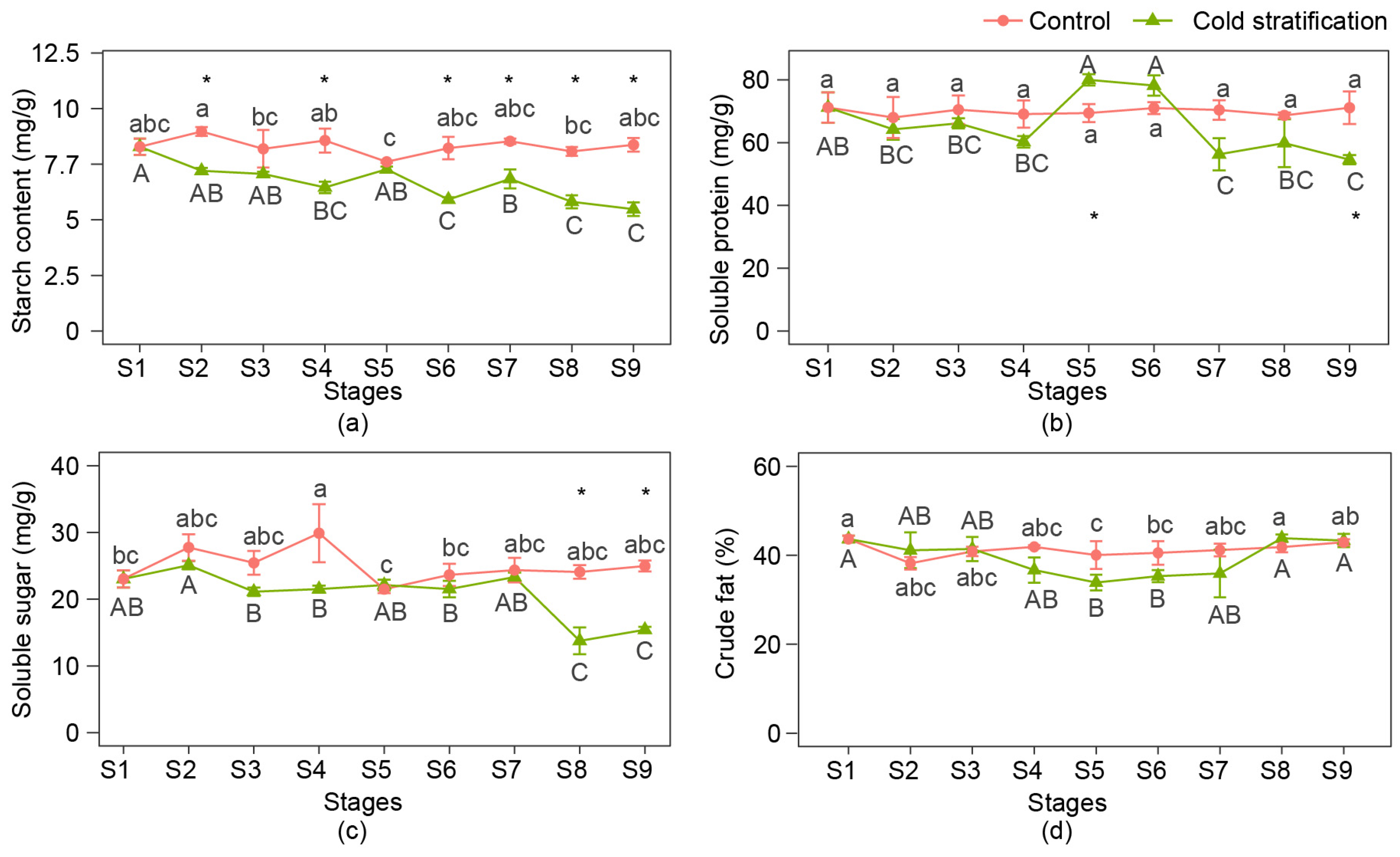Morphology and Physiology Response to Stratification during Seeds Epicotyl Dormancy Breaking of Paeonia emodi Wall. ex Royle
Abstract
1. Introduction
2. Materials and Methods
2.1. Plant Materials and Stratification Treatment
2.2. Morphological Observation of Embryos
2.3. Determination of Nutrient Content, Related Enzyme Activities and Endogenous Hormones
2.4. Data Processing and Analysis
3. Results
3.1. Morphological Changes of Embryos during Cold Stratification
3.2. Changes in Nutrient Content during Stratification
3.3. Changes in Enzyme Activities Related to Nutrient Decomposition during Stratification
3.4. Changes in Endogenous Hormone Content during Stratification
3.5. Correlation Analysis between Hormones and Nutrients under Cold Stratification
4. Discussion
5. Conclusions
Author Contributions
Funding
Data Availability Statement
Conflicts of Interest
References
- Hong, D. Peonies of the World: Taxonomy and Phytogeography; Royal Botanic Gardens: Richmond, UK, 2010; pp. 118–122. [Google Scholar]
- Ahmad, M.; Malik, K.; Tariq, A.; Zhang, G.; Yaseen, G.; Rashid, N.; Sultana, S.; Zafar, M.; Ullah, K.; Khan, M.P.Z. Botany, ethnomedicines, phytochemistry and pharmacology of Himalayan paeony (Paeonia emodi Royle.). J. Ethnopharmacol. 2018, 220, 197–219. [Google Scholar] [CrossRef] [PubMed]
- Zhang, K.; Pan, H.; Baskin, C.C.; Baskin, J.M.; Xiong, Z.; Cao, W.; Yao, L.; Tang, B.; Zhang, C.; Tao, J. Epicotyl morphophysiological dormancy in seeds of Paeonia ostii (Paeoniaceae): Seasonal temperature regulation of germination phenology. Environ. Exp. Bot. 2022, 194, 104742. [Google Scholar] [CrossRef]
- Porceddu, M.; Mattana, E.; Pritchard, H.W.; Bacchetta, G. Sequential temperature control of multi-phasic dormancy release and germination of Paeonia corsica seeds. J. Plant Ecol. 2015, 9, 464–473. [Google Scholar] [CrossRef]
- Yu, X.; Zhao, R.; Cheng, F. Seed germination of tree and herbaceous peonies: A mini-review. Seed Sci. Biotechnol 2014, 1, 11–14. [Google Scholar]
- Zhang, M.; Wan, Y.; Li, B.; Gao, J.; Zhou, H.; Liu, Y. Methods of breaking dormancy in Paeonia emodi seed. In Proceedings of the China Ornamental Horticulture Symposium, Beijing, China, 2020; pp. 260–263, (In Chinese with English abstract). [Google Scholar]
- Ren, X.-X.; Xue, J.-Q.; Wang, S.-L.; Xue, Y.-Q.; Zhang, P.; Jiang, H.-D.; Zhang, X.-X. Proteomic analysis of tree peony (Paeonia ostii ‘Feng Dan’) seed germination affected by low temperature. J. Plant Physiol. 2018, 224–225, 56–67. [Google Scholar] [CrossRef] [PubMed]
- Zhang, K.; Yao, L.; Zhang, Y.; Baskin, J.M.; Baskin, C.C.; Xiong, Z.; Tao, J. A review of the seed biology of Paeonia species (Paeoniaceae), with particular reference to dormancy and germination. Planta 2019, 249, 291–303. [Google Scholar] [CrossRef]
- Li, W.; Zhang, S.; Tang, H.; He, L. Effect of exogenous gibberellic acid on Paeonia rockii seeds germination. Acta Bot. Boreali-Occident. Sin. 2019, 39, 1819–1826. [Google Scholar]
- Chen, S.-Y.; Chou, S.-H.; Tsai, C.-C.; Hsu, W.-Y.; Baskin, C.C.; Baskin, J.M.; Chien, C.-T.; Kuo-Huang, L.-L. Effects of moist cold stratification on germination, plant growth regulators, metabolites and embryo ultrastructure in seeds of Acer morrisonense (Sapindaceae). Plant Physiol. Biochem. 2015, 94, 165–173. [Google Scholar] [CrossRef]
- Li, X.; Fei, R.; Chen, Z.; Fan, C.; Sun, X. Plant hormonal changes and differential expression profiling reveal seed dormancy removal process in double dormant plant-herbaceous peony. PLoS ONE 2020, 15, e0231117. [Google Scholar] [CrossRef]
- Wan, Y.; Zhang, M.; Hong, A.; Lan, X.; Yang, H.; Liu, Y. Transcriptome and weighted correlation network analyses provide insights into inflorescence stem straightness in Paeonia lactiflora. Plant Mol. Biol. 2020, 102, 239–252. [Google Scholar] [CrossRef]
- Yu, X.; Yu, H.; Zhang, J.; Shao, S.; Xiong, F.; Wang, Z. Endosperm structure and physicochemical properties of starches from normal, waxy, and super-sweet maize. Int. J. Food Prop. 2015, 18, 2825–2839. [Google Scholar] [CrossRef]
- Kaur, S.; Kumar, P. Ameliorative effect of trichoderma, rhizobium and mycorrhiza on internodal length, leaf area and total soluble protein in mung bean (Vigna radiata [L.] R. Wilazek) under drought stress. J. Pharmacogn. Phytochem. 2020, 9, 971–977. [Google Scholar]
- Fei, R.; Sun, X.; Yang, P.; Chen, Z.; Ma, Y. Anatomical observation of Paeonia lactiflora seeds during stratification process. J. Shenyang Agric. Univ. 2017, 48, 354–359, (In Chinese with English abstract). [Google Scholar]
- Zeeman, S.C.; Kossmann, J.; Smith, A.M. Starch: Its metabolism, evolution, and biotechnological modification in plants. Annu. Rev. Plant Biol. 2010, 61, 209–234. [Google Scholar] [CrossRef]
- Shao, C.; Wang, G.; Ding, X.; Yang, C.; Yan, M. Physiological and biochemical characteristics of cold stratification to overcome morphophysiological dormancy in Glehnia littoralis seed. Seed Sci. Technol. 2021, 49, 19–24. [Google Scholar] [CrossRef]
- Zhang, J.; Qian, J.-Y.; Bian, Y.-H.; Liu, X.; Wang, C.-L. Transcriptome and metabolite conjoint analysis reveals the seed dormancy release process in callery pear. Int. J. Mol. Sci. 2022, 23, 2186. [Google Scholar] [CrossRef]
- Liu, X.; Huang, X.; Kong, X.-X.; Zhang, J.; Wang, J.-Z.; Yang, M.-L.; Wang, C.-L. Sucrose synthase is involved in the carbohydrate metabolism-based regulation of seed dormancy release in Pyrus calleryana Decne. J. Hortic. Sci. Biotechnol. 2020, 95, 590–599. [Google Scholar] [CrossRef]
- Liu, L.; Xia, W.; Li, H.; Zeng, H.; Wei, B.; Han, S.; Yin, C. Salinity Inhibits Rice Seed Germination by Reducing α-Amylase Activity via Decreased Bioactive Gibberellin Content. Front. Plant Sci. 2018, 9, 275. [Google Scholar] [CrossRef]
- Sheng, Y.; Xiao, H.; Guo, C.; Wu, H.; Wang, X. Effects of exogenous gamma-aminobutyric acid on α-amylase activity in the aleurone of barley seeds. Plant Physiol. Biochem. 2018, 127, 39–46. [Google Scholar] [CrossRef]
- Zaynab, M.; Pan, D.; Fatima, M.; Sharif, Y.; Chen, S.; Chen, W. Proteomics analysis of Cyclobalanopsis gilva provides new insights of low seed germination. Biochimie 2021, 180, 68–78. [Google Scholar] [CrossRef]
- Yan, Z.G.; Xie, L.H.; Wang, N.; Sun, D.Y.; Bai, Z.Z.; Niu, L.X.; Zhang, Y.L.; Ji, X.T. Phenotypic characteristics and fatty acid composition of seeds from different herbaceous peony species native to China. Chem. Biodivers. 2019, 16, e1800589. [Google Scholar] [CrossRef] [PubMed]
- Zhang, Y.; Luo, J.; Zeng, F. Volatile composition analysis of tree peony (Paeonia section Moutan DC.) seed oil and the effect of oxidation during storage. J. Food Sci. 2021, 86, 3467–3479. [Google Scholar] [CrossRef] [PubMed]
- Xue, J.; Wang, S.; Zhang, P.; Zhu, F.; Ren, X.; Liu, C.; Zhang, X. On the role of physiological substances, abscisic acid and its biosynthetic genes in seed maturation and dormancy of tree peony (Paeonia ostii ‘Feng Dan’). Sci. Hortic. 2015, 182, 92–101. [Google Scholar] [CrossRef]
- Gerivani, Z.; Vashaee, E.; Sadeghipour, H.R.; Aghdasi, M.; Shobbar, Z.-S.; Azimmohseni, M. Short versus long term effects of cyanide on sugar metabolism and transport in dormant walnut kernels. Plant Sci. 2016, 252, 193–204. [Google Scholar] [CrossRef]
- Zhao, Y.; Ma, Y.; Li, Q.; Yang, Y.; Guo, J.; Song, J. Utilisation of stored lipids during germination in dimorphic seeds of euhalophyte Suaeda salsa. Funct. Plant Biol. 2018, 45, 1009–1016. [Google Scholar] [CrossRef]
- Sun, H.; Li, Q.; Zhu, M.; Li, Y.; Li, S. Dynamic changes of nutrients of Paeonia ostii ‘Feng Dan’ seed during its dormancy breaking. J. Nanjing For. Univ. 2021, 45, 70–78, (In Chinese with English abstract). [Google Scholar]
- Zhao, M.; Zhang, H.; Yan, H.; Qiu, L.; Baskin, C.C. Mobilization and role of starch, protein, and fat reserves during seed germination of six wild grassland species. Front. Plant Sci. 2018, 9, 234. [Google Scholar] [CrossRef]
- Theodoulou, F.L.; Eastmond, P.J. Seed storage oil catabolism: A story of give and take. Curr. Opin. Plant Biol. 2012, 15, 322–328. [Google Scholar] [CrossRef]
- Yue, J.; Li, M. Review of the mobilization and change of seed storage materials during germination. Seed 2021, 40, 56–62, (In Chinese with English abstract). [Google Scholar]
- Rudolph, M.; Schlereth, A.; Körner, M.; Feussner, K.; Berndt, E.; Melzer, M.; Hornung, E.; Feussner, I. The lipoxygenase-dependent oxygenation of lipid body membranes is promoted by a patatin-type phospholipase in cucumber cotyledons. J. Exp. Bot. 2010, 62, 749–760. [Google Scholar] [CrossRef]
- Zou, Y.; Zhu, M.; Li, Y.; Zhai, J.; Li, S. Daynamic changes in nutrients content and related enzymes activity during Paeonia ostii ‘Feng Dan’ seeds development. J. Nanjing For. Univ. 2021, 45, 62–70, (In Chinese with English abstract). [Google Scholar]
- Iwasaki, M.; Penfield, S.; Lopez-Molina, L. Parental and Environmental Control of Seed Dormancy in Arabidopsis thaliana. Annu. Rev. Plant Biol. 2022, 73, 355–378. [Google Scholar] [CrossRef] [PubMed]
- Hao, H.-P.; He, Z.; Li, H.; Shi, L.; Tang, Y.-D. Effect of root length on epicotyl dormancy release in seeds of Paeonia ludlowii, Tibetan peony. Ann. Bot. 2013, 113, 443–452. [Google Scholar] [CrossRef] [PubMed]
- Liu, Y.; Fang, J.; Xu, F.; Chu, J.; Yan, C.; Schläppi, M.R.; Wang, Y.; Chu, C. Expression patterns of ABA and GA metabolism genes and hormone levels during rice seed development and imbibition: A comparison of dormant and non-dormant rice cultivars. J. Genet. Genom. 2014, 41, 327–338. [Google Scholar] [CrossRef] [PubMed]
- Verma, V.; Ravindran, P.; Kumar, P.P. Plant hormone-mediated regulation of stress responses. BMC Plant Biol. 2016, 16, 86. [Google Scholar] [CrossRef]
- Wang, L.; Chen, X.; Yang, Y.; Wang, Z.; Xiong, F. Effects of exogenous gibberellic acid and abscisic acid on germination, amylases, and endosperm structure of germinating wheat seeds. Seed Sci. Technol. 2016, 44, 64–76. [Google Scholar] [CrossRef]
- Shahpiri, A.; Talaei, N.; Finnie, C. Spatio-temporal appearance of α-amylase and limit dextrinase in barley aleurone layer in response to gibberellic acid, abscisic acid and salicylic acid. J. Sci. Food Agric. 2015, 95, 141–147. [Google Scholar] [CrossRef][Green Version]




| Starch Content | Soluble Sugar Content | Soluble Protein Content | Crude Fat Content | α-Amylase Activity | β-Amylase Activity | Acid Protease Activity | Lipase Activity | |
|---|---|---|---|---|---|---|---|---|
| ABA content | 0.189 | 0.378 | 0.069 | 0.093 | −0.026 | 0.171 | −0.408 | 0.190 |
| GA3 content | −0.552 | −0.387 | −0.672 * | 0.111 | 0.789 * | 0.530 | 0.421 | 0.612 |
| ABA/GA3 | 0.684 * | 0.609 | 0.624 | 0.080 | −0.788 * | −0.467 | −0.651 | −0.546 |
Publisher’s Note: MDPI stays neutral with regard to jurisdictional claims in published maps and institutional affiliations. |
© 2022 by the authors. Licensee MDPI, Basel, Switzerland. This article is an open access article distributed under the terms and conditions of the Creative Commons Attribution (CC BY) license (https://creativecommons.org/licenses/by/4.0/).
Share and Cite
Wan, Y.; Zhang, M.; Liu, A.; Yuan, Q.; Liu, Y. Morphology and Physiology Response to Stratification during Seeds Epicotyl Dormancy Breaking of Paeonia emodi Wall. ex Royle. Agronomy 2022, 12, 1745. https://doi.org/10.3390/agronomy12081745
Wan Y, Zhang M, Liu A, Yuan Q, Liu Y. Morphology and Physiology Response to Stratification during Seeds Epicotyl Dormancy Breaking of Paeonia emodi Wall. ex Royle. Agronomy. 2022; 12(8):1745. https://doi.org/10.3390/agronomy12081745
Chicago/Turabian StyleWan, Yingling, Min Zhang, Aiqing Liu, Qiuping Yuan, and Yan Liu. 2022. "Morphology and Physiology Response to Stratification during Seeds Epicotyl Dormancy Breaking of Paeonia emodi Wall. ex Royle" Agronomy 12, no. 8: 1745. https://doi.org/10.3390/agronomy12081745
APA StyleWan, Y., Zhang, M., Liu, A., Yuan, Q., & Liu, Y. (2022). Morphology and Physiology Response to Stratification during Seeds Epicotyl Dormancy Breaking of Paeonia emodi Wall. ex Royle. Agronomy, 12(8), 1745. https://doi.org/10.3390/agronomy12081745





